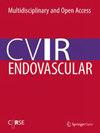In vitro study of the embolic characteristics of imipenem/cilastatin particles
IF 1.2
Q3 CARDIAC & CARDIOVASCULAR SYSTEMS
引用次数: 0
Abstract
Imipenem/cilastatin (IPM/CS) has long been administered intravenously as a carbapenem antibiotic. However, since this agent is poorly soluble in liquid, occasional reports have described its use as a short-acting, temporary embolic agent. The purpose of this study was to elucidate the characteristics of IPM/CS particles, which are thought to have pain-relieving effects against osteoarthritis-related pain, as an embolic agent. Three aspects of IPM/CS as an embolic agent were evaluated in vitro: particle size; particle shape; and change in particle size over time. For particle size, the long diameter was measured. Mean particle size (n=244) was 29.2±12.0 µm (range, 1–60 µm). Shape (n=109) was round in 18.35%, elliptical in 11.93%, and polygonal in 69.72%, showing that most particles were polygonal. In observations of changes in particle size over time (n=9), particles had decreased to 75% of their original size at 82±10.7 min, 50% at 89.3±9.14 min, 25% at 91.3±8.74 min, complete dissolved at 91.8±9.02 min. A rapid shrinkage in diameter was seen in the final period. IPM/CS particles are ultrafine and the majority display a polygonal shape. This substance shows ultra-short embolic activity. This study revealed the characteristics of a substance that demonstrates an embolic effect not found in existing embolic materials.亚胺培南/西司他丁颗粒栓塞特性的体外研究
长期以来,亚胺培南/西司他丁(IPM/CS)一直作为碳青霉烯类抗生素进行静脉注射。然而,由于这种药剂在液体中的溶解度很低,因此偶尔有报道称它可用作短效、暂时性的栓塞剂。本研究的目的是阐明 IPM/CS 微粒作为栓塞剂的特性,这种微粒被认为对骨关节炎相关疼痛具有止痛效果。研究从三个方面对 IPM/CS 作为栓塞剂进行了体外评估:颗粒大小、颗粒形状和颗粒大小随时间的变化。在粒径方面,测量的是长直径。平均粒径(n=244)为 29.2±12.0 微米(范围为 1-60 微米)。形状(n=109)为圆形的占 18.35%,椭圆形的占 11.93%,多角形的占 69.72%,表明大多数颗粒为多角形。在观察颗粒大小随时间的变化时(n=9),82±10.7 分钟时颗粒缩小到原来大小的 75%,89.3±9.14 分钟时缩小到原来大小的 50%,91.3±8.74 分钟时缩小到原来大小的 25%,91.8±9.02 分钟时完全溶解。在最后阶段,直径迅速缩小。IPM/CS 颗粒超细,大部分呈多边形。这种物质具有超短栓塞活性。这项研究揭示了一种物质的特性,它具有现有栓塞材料所没有的栓塞效果。
本文章由计算机程序翻译,如有差异,请以英文原文为准。
求助全文
约1分钟内获得全文
求助全文
来源期刊

CVIR Endovascular
Medicine-Radiology, Nuclear Medicine and Imaging
CiteScore
2.30
自引率
0.00%
发文量
59
 求助内容:
求助内容: 应助结果提醒方式:
应助结果提醒方式:


